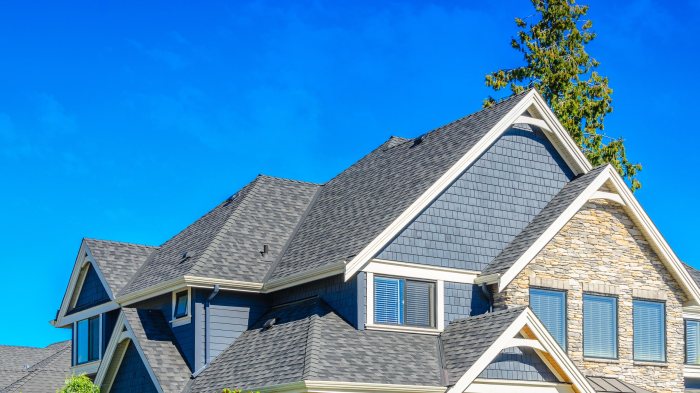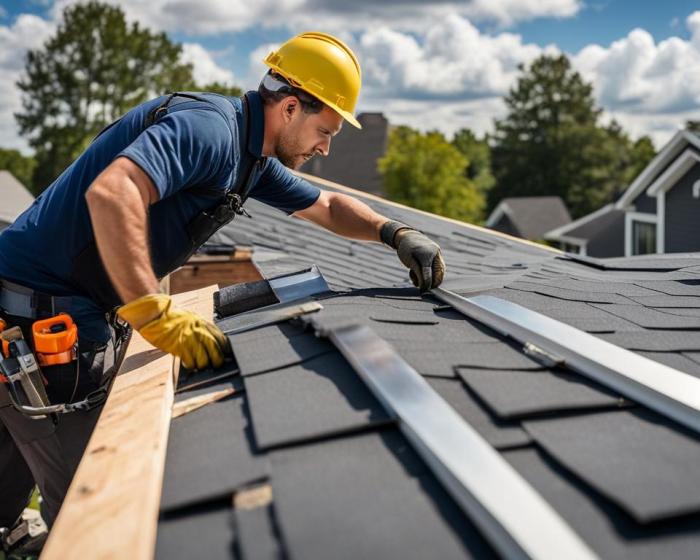The Ultimate Guide to Roofing and Siding Specialists
Exploring the world of roofing and siding specialists, this comprehensive guide dives deep into the role, skills, materials, repairs, safety practices, and design trends of these professionals. From the basics to the latest innovations, this engaging narrative sheds light on everything you need to know about roofing and siding specialists.
Whether you're a homeowner looking to understand more about these specialists or someone considering a career in this field, this guide has you covered with valuable insights and practical information.
Introduction to Roofing and Siding Specialists

Roofing and siding specialists play a crucial role in construction projects by ensuring that buildings are protected from the elements and maintain structural integrity. These professionals are tasked with the installation, repair, and maintenance of roofing and siding materials to safeguard properties against weather conditions and enhance their aesthetic appeal.
Skills and Expertise
Roofing and siding specialists require a diverse set of skills and expertise to excel in their field. Some of the key abilities include:
- Knowledge of various roofing and siding materials
- Understanding of building codes and regulations
- Proficiency in measuring and cutting materials accurately
- Ability to work safely at heights
- Strong problem-solving skills
Importance of Hiring Qualified Professionals
It is essential to hire qualified roofing and siding specialists for installations to ensure the longevity and quality of the work. Qualified professionals not only possess the necessary skills and expertise but also have access to the right tools and equipment to carry out the job effectively.
By entrusting your roofing and siding needs to experienced specialists, you can rest assured that the work will be done correctly and up to industry standards.
Types of Roofing Materials
When it comes to choosing the right roofing material for your home, there are several options available, each with its own set of advantages and disadvantages. Roofing and siding specialists are well-versed in the characteristics of different roofing materials to help you make an informed decision based on your needs and budget.
Asphalt Shingles
Asphalt shingles are one of the most common roofing materials used by homeowners due to their affordability and ease of installation. They come in a variety of colors and styles, making them a versatile option for many homes. While asphalt shingles have a relatively shorter lifespan compared to other materials, they are cost-effective and can withstand moderate weather conditions.
Metal Roofing
Metal roofing is known for its durability and longevity, making it a popular choice for homeowners looking for a long-term roofing solution. While metal roofs can be more expensive upfront, they require minimal maintenance and have a lifespan of 40-70 years.
Additionally, metal roofing is energy-efficient and can help reduce heating and cooling costs.
Clay Tiles
Clay tiles are a timeless and elegant roofing option that adds a touch of sophistication to any home. While clay tiles are more expensive than asphalt shingles, they have a longer lifespan of 50-100 years and are resistant to fire, insects, and rot.
However, clay tiles are heavier than other materials and may require additional structural support during installation.
Siding Options and Installation
When it comes to siding options for your home, there are several popular choices available, each with its own unique benefits and considerations. From vinyl to wood, fiber cement, and stucco, the type of siding you choose can significantly impact the look, durability, and maintenance requirements of your property.
Vinyl Siding
Vinyl siding is a popular choice due to its affordability, low maintenance, and versatility in terms of colors and styles. Installation typically involves interlocking panels that are nailed to the exterior of the house, making it a relatively straightforward process that can be completed efficiently.
Wood Siding
Wood siding offers a natural and timeless look, but it requires more maintenance compared to other options. Installation involves attaching wooden planks or shingles to the exterior of the home, which requires precision and expertise to ensure proper sealing and protection against the elements.
Fiber Cement Siding
Fiber cement siding is a durable and low-maintenance option that can mimic the look of wood or masonry. Installation involves cutting and fitting fiber cement boards onto the exterior of the house, which requires specialized tools and knowledge to ensure a proper fit and finish.
Stucco Siding
Stucco siding provides a classic and textured appearance that can enhance the aesthetic appeal of your home. Installation involves applying multiple layers of stucco mixture to the exterior walls, which requires skill and experience to achieve a smooth and uniform finish that will last for years to come.It is essential to consider the maintenance requirements and longevity of each siding material before making a decision.
While vinyl siding may require minimal upkeep, wood siding may need regular painting or staining to maintain its appearance. Fiber cement and stucco siding are durable options that can last for decades with proper care and maintenance, making them excellent choices for homeowners looking for long-term solutions.
Roofing and Siding Repairs
When it comes to roofing and siding repairs, specialists often encounter common issues such as roof leaks, damaged shingles, or siding cracks. These problems can arise due to various factors like weather conditions, age of the materials, or improper installation.
Diagnosing and Fixing Roof Leaks
- Inspect the roof for visible signs of damage such as missing shingles, cracked flashing, or water stains on the ceiling.
- Use a hose to simulate rain and locate the source of the leak by checking for water entry points.
- Repair the damaged area by replacing shingles, sealing flashing, or applying a waterproof membrane as needed.
Repairing Damaged Shingles
- Identify the extent of shingle damage by looking for curling, cracking, or missing pieces.
- Remove the damaged shingles carefully and replace them with new ones to ensure a secure and watertight seal.
- Consider hiring a professional if the damage is extensive or if you are unsure about the repair process.
Fixing Siding Cracks
- Inspect the siding for cracks, warping, or discoloration that may indicate underlying damage.
- Clean the affected area and apply a suitable patching compound to fill in the cracks and restore the siding's integrity.
- Seek professional assistance if the cracks are widespread or if the siding material needs to be replaced.
Safety Practices in Roofing and Siding Work
When it comes to roofing and siding work, safety should always be a top priority for specialists. Following proper safety protocols and measures not only protects the workers but also ensures the quality and efficiency of the job.
Importance of Personal Protective Equipment (PPE)
Using personal protective equipment (PPE) is crucial in roofing and siding installations to prevent injuries and accidents. Specialists should always wear items such as hard hats, safety glasses, gloves, and non-slip footwear to protect themselves from falling debris, sharp materials, and slippery surfaces.
Potential Hazards and Mitigation
- 1. Falls: Roofing and siding work often involves working at heights, increasing the risk of falls. To mitigate this hazard, specialists should use proper fall protection equipment such as harnesses and guardrails.
- 2. Electrical Hazards: Working with power tools and near electrical lines can pose a risk of electrocution. It is essential to always be aware of electrical hazards and follow safety guidelines to avoid accidents.
- 3. Material Handling: Heavy roofing materials and equipment can lead to back injuries if not handled properly. Specialists should use proper lifting techniques and equipment to prevent strains and sprains.
- 4. Weather Conditions: Adverse weather conditions like rain, wind, or extreme heat can create hazardous working conditions. It is important for specialists to be aware of weather forecasts and take necessary precautions to ensure safety.
Trends in Roofing and Siding Design
In the world of roofing and siding, design trends are constantly evolving to meet the needs and preferences of homeowners. From eco-friendly options to modern aesthetics, there are several exciting developments shaping the industry today.
Eco-Friendly Roofing and Siding
As sustainability becomes a top priority for many homeowners, eco-friendly roofing and siding options are gaining popularity. Materials such as recycled metal, reclaimed wood, and sustainable composites are being used to create environmentally conscious designs. These materials not only reduce the carbon footprint of a home but also provide a unique and stylish look.
Technology Integration in Roofing and Siding
Advancements in technology are revolutionizing the roofing and siding industry. From solar panel integration on roofs to smart siding materials that adjust to weather conditions, homeowners now have access to innovative solutions that enhance both the functionality and aesthetics of their homes.
These technological advancements not only improve energy efficiency but also offer a modern and sophisticated design.
Innovative Design Elements
Innovative roofing and siding projects are pushing the boundaries of traditional design concepts. Architectural shingles, geometric patterns, mixed material combinations, and bold color choices are just a few examples of how homeowners are incorporating unique elements into their roofing and siding designs.
These avant-garde approaches not only add visual interest but also create a personalized and distinctive look for each home.
Concluding Remarks

In conclusion, roofing and siding specialists play a crucial role in the construction industry, ensuring durable and visually appealing structures. By understanding their significance, skills required, types of materials used, safety practices, and design trends, you're equipped to make informed decisions when it comes to roofing and siding projects.
Dive into this world of specialists and elevate your knowledge to new heights.
FAQ
What skills are required to become a successful roofing and siding specialist?
To excel in this field, one needs a combination of technical skills, attention to detail, physical strength, and the ability to work at heights safely.
How can homeowners identify common issues that require roofing and siding repairs?
Look out for signs such as water leaks, damaged shingles, or cracks in siding, which may indicate the need for repairs.
What are some popular siding options used by specialists?
Vinyl, wood, fiber cement, and stucco are among the commonly used siding materials due to their durability and aesthetic appeal.
What safety measures should roofing and siding specialists follow?
They should adhere to safety protocols, use personal protective equipment, and be aware of potential hazards to ensure a secure work environment.




